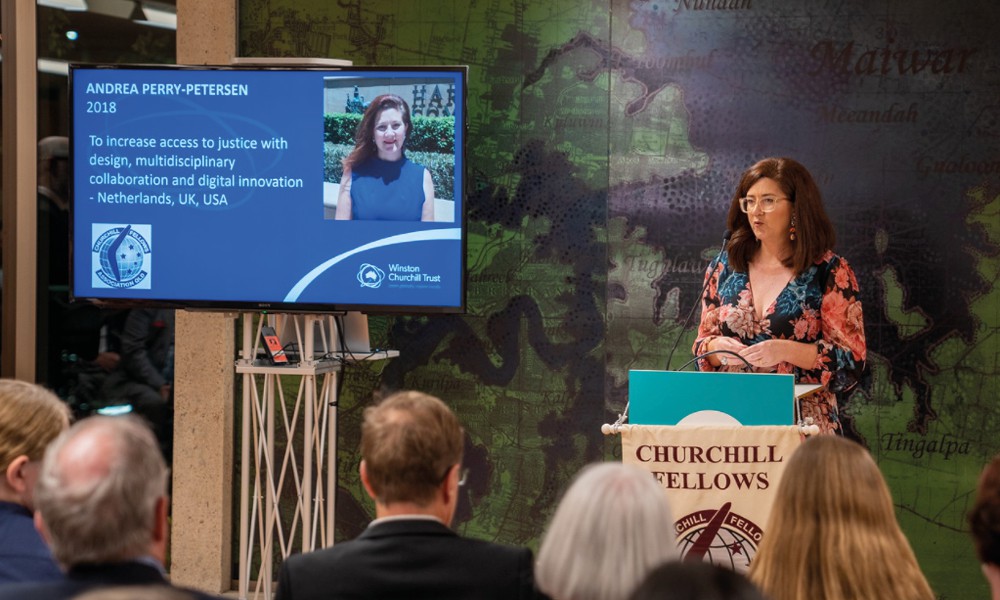Andrea Perry-Petersen, who was awarded a Winston Churchill Trust fellowship in 2018, has now completed her research project, which examines ways to increase access to justice through design, multidisciplinary collaboration and digital innovation.
Andrea has become well known in the Queensland legal community since her admission in 1996, having worked as a clinical legal educator at a community legal centre, a researcher with the TC Beirne School of Law, a consultant to law firms and legal technology companies, and a teacher at QUT.
Andrea won the Queensland Law Society 2019 Innovation in Law Award and is a member of the QLS Innovation Committee. She was presented with the Churchill Trust medallion at a State Library function on 25 September (pictured).
Following is an edited version of the executive summary from her work, ‘A manifesto to transform access to civil legal services’, with the complete report available from the Winston Churchill Trust website:
The need
At the same time as many people experience legal issues relating to their employment, housing or family situations, they experience significant challenges in identifying and applying accurate legal information, securing affordable legal assistance and resolving their disputes.
Analysis of legal needs in Australia reveals that these challenges are disproportionately experienced by the most vulnerable people in our society, compounding social, economic and health problems.
As well, insufficient funding for legal assistance is leading to growing numbers of self-represented litigants (SRLs) in turn increasing pressure on tribunals, courts, and the overall administration of justice.
Fellowship research
The problems of unequal access to justice are well known and well documented. My project sought to address such problems by identifying innovative approaches having positive impact in the United States, the Netherlands and the United Kingdom.
The aim was to document practical strategies for legislators, policy makers, legal providers, entrepreneurs and academics to implement and bridge the justice gap in Australia.
Adequate legal aid funding should be available to assist clients for whom technology is not suited and traditional models of one-to-one legal service delivery are most appropriate. Unfortunately, government funded legal service funding has been inadequate for decades and likely to remain so.
Principles of human-centred design, multidisciplinary collaboration and digital innovation have huge potential to address this challenge – to develop new processes and systems and in an increasingly digital world, provide affordable and convenient solutions for large numbers of people. This approach constitutes a new evolution in the delivery of legal services, comparable to that of community delivery that emerged in the 1970s and 1980s.
I want to make two points very clear. Firstly, innovation does not equate with technology. Additionally, the three key approaches I refer to above as “innovative approaches” were the focus of my research but are not the only innovations and initiatives (such as community legal education, fixed and value pricing, ‘low bono’ and unbundling models, public and potentially private litigation funding, insurance schemes and joined-up services) which contribute to improving the status quo.
Over the course of my research, I met with leaders and change-makers working on these approaches within legal assistance organisations, law firms, entrepreneurial legal technology start-ups, regulatory bodies as well as academics and researchers.
It was outside the scope of my research to interview court staff, however many of the people I interviewed had views based on their experience, about how these approaches could apply in the context of dispute resolution, including in courts and tribunals.
This intense period of research added greatly to my understanding about the law’s capacity to meet the needs of everyday people, especially when delivered in ways that are readily accessible to them. A significant benefit of the research was the time to gather and synthesise viewpoints from diverse stakeholders across the justice ecosystem, which enabled me to develop an holistic view of the possibilities and challenges.
The information in this report is intended for people and organisations interested in improving access to justice in Australia (although it has application in other jurisdictions) and is especially aimed at change-makers seeking to improve people’s experience of the law through innovative approaches.
Fellowship report
The report is structured into themes and within each:
- a definition (‘What is this about?’)
- an explanation of the relevance (‘Why is this important?’)
- examples of best practice (from case studies and interviews)
- conclusions and
- recommendations.
This Executive summary outlines some conclusions and recommendations, with greater detail provided throughout the report (including in footnotes). Readers are also encouraged to listen to the ‘Reimagining Justice’ podcast which provides additional relevant content.1
Call to action
This report is more than an exercise in collating and sharing information, it is a call to action.
We must inform and equip ourselves with the skills necessary to address complex challenges, to exercise greater collaboration in the public interest and bold leadership.
Investment will be required not only from people innovating at the coalface but by policymakers with the power to ensure adequate resourcing and who can champion a unified vision for innovation and access to justice in Australia.
The payoff for all is improved delivery of legal services at scale, at more affordable rates than traditional models of lawyer-client provision and an overall improvement in the administration of justice.
Conclusions and recommendations vary from specific and pragmatic suggestions about improving legal service delivery, to broad-scale reform and systemic change. The suggestions are likely to be considered aspirational or controversial by some, by others as familiar and long overdue.
Some of the recommendations will be readily implemented, others are ambitious and will require significant resources, and many require a change in mindset and culture. Implementing the recommendations is necessary to allow for a broader range of options and flexibility in the delivery of legal services to guarantee that Australia’s legal system can meaningfully serve the needs of everyday Australians.
Conclusions and recommendations
It will take a combination of education, process improvement, digital implementation, research and policy reform before we see significant improvement in people’s ability to understand and access the law.
In summary, for innovation to improve access to justice in Australia:
- law students and lawyers should receive education regarding access to justice issues and innovative approaches to address evolving societal challenges
- human-centred design principles which focus on the legal consumer should be utilised when considering reform of existing legal processes and design of new systems and programs
- the possibilities of digital innovation need to be understood and the applications that are most effective to improve legal consumers experience and scale legal assistance, implemented
- data collection relating to legal needs and program impacts should be undertaken, as well as rigorous evaluation of programs
- where there is effectively no market for legal assistance, funding must be made available by government and where there is a market, more sources of sustainable funding identified
- regulation must focus on outcomes and its impact on legal consumers
- significant increase in collaboration between various stakeholders is essential, and
- there must be bold leadership at local and national levels.
The findings are comprehensively set out in Appendix B – Recommendations although I set out a summary here:
Transformation of education will increase law students’, lawyers’, policy and decision-makers’ awareness of justice problems and innovative approaches which will equip them with the skills to address them – through ‘Law labs’, fellowships and tailored professional development.
Human-centred design has the potential to resolve the chasm between the legal profession and the public by improving the experience of the law for litigants, advocates and decision-makers by overcoming barriers and improving trust in the system.
Legal service providers, courts and tribunals should incorporate human-centred design in delivering information and developing processes and systems. In essence this is about removing barriers – from legislation, regulation, practice, court forms etc. – between the needs of legal consumers and their ability to engage with the law.
Digital innovation such as tailored guidance and simplified court forms developed with human-centred design principles have the potential to improve legal consumers’ experience of the law and facilitate effective access at scale. Data collected ethically from these sources could provide information about legal needs and program impact and be useful for systemic advocacy.
Unlike the Legal Services Corporation Technology Initiative Grant Program, which awarded US$4 million in 2020, Australia does not have dedicated funding for justice innovation. But where market incentives are limited, it is critical. This report calls for well-administered public funding for projects most likely to result in impact based on rigorous evaluation and which satisfy key criteria for best practices.
There is potential for entrepreneurs to develop sustainable legal businesses through a combination of digital innovation and innovative practice models especially to serve ‘the missing middle’. This report contains examples of sustainable business models having impact.
Greater attention should be given, and dedicated funding made available for data collection frameworks embedded in legal assistance programs, tribunals and courts. More meaningful data about current legal needs and interventions having the most impact is necessary to form an evidence base to set funding priorities and for systemic reform.
Best practices for evaluating projects, especially those providing online assistance, should be developed, and implemented by the legal assistance sector.
Greater consideration needs to be given to oversight and evaluation of digital solutions, especially those implemented with limited human oversight which aim to assist vulnerable, low-income and disadvantaged legal consumers or SRLs. Accordingly, standards for digital solutions that assist everyday legal consumers (clients of low and moderate means and SRLs) should be developed by a multidisciplinary organisation not comprised solely of lawyers.
Everyday legal consumers do not have the influence of stakeholders such as law firms and big business, nor are they likely to be members of an organisation which represents their views as relates to the legal system. Establishing an advisory body to represent and advocate for legal consumers and SRLs is recommended.
Rules of professional legal regulation ought to reflect current societal norms, and uphold the highest professional standards while balancing protection of the consumer. Given the opportunities to increase access to justice presented by ‘non-traditional’ legal service delivery such as unbundling, licensed paraprofessionals and digital innovation, models of regulation require review.
A regulatory sandbox could consider the possibility of a scheme for licensed paraprofessionals and/or consumer-facing digital solutions, providing more options for legal consumers. Clarifying or reframing existing rules provides certainty for legal innovators and confidence for investment in initiatives which serve the latent legal market.
Innovative solutions improving access to justice are being developed by a range of legal service providers, including not-for-profit organisations, legal technology entrepreneurs, law firms and courts.
Collaboration is critical to maximise limited resources and to develop strategy for change at scale.
Importantly a national and independent multidisciplinary organisation should be established to coordinate stakeholders, compile an inventory of justice innovations and best practices and set national priorities.
Finally, to envision and realise a future in which access to justice is no longer the challenge it is today for many, Australia needs bold and courageous leadership.
I trust that the information contained in this report, the examples and observations, conclusions and recommendations contribute to this vision.
Footnote
1 Andrea Perry-Petersen, ‘Reimagining Justice Podcast’ (podcast host webpage, 2019).













Share this article